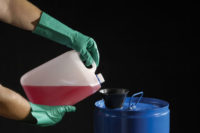Safety gloves provide a layer of protection for your hands and shield them from different types of hazards on the job, including cuts, scratches, punctures, and burns. That’s why it’s important to replace your gloves as needed. Ignoring signs of disrepair can lead to injuries on the job. Here’s what you need to know about replacing your safety gloves.
Do safety gloves have a shelf life?
The working life of your safety gloves depends largely on the material. Disposable natural latex gloves will start to lose their protective properties after three years, while nitrile disposable gloves will last up to five years. Kevlar gloves will usually start to degrade after 10 washes. Gloves made with polyvinyl chloride (vinyl), neoprene, and polyurethane tend to last five years or more. Some gloves will even last up to 10 years depending on how often they are used and where they are stored. High-quality leather gloves can even potentially last a lifetime. Check for a manufacturing date and follow manufacturer guidelines or recommendations on when to use your gloves by.
The longevity of your gloves also depends on how well you maintain them, how often you’re using them, and the type of work you’re using them for. The more dangerous or dirty the job, the more your gloves will need to be maintained. Refer to the manufacturer’s guidelines to extend the working life of your glove as much as possible.
Regardless of how long you’ve been using your gloves, there are several warning signs that they need to be replaced. Keep your eyes out for these red flags:
Fraying of materials
The materials used to make the glove may start to come undone over time. Watch out for loose threads, rips, holes, or a noticeable absence of material. Sharp objects can easily poke a hole in the fabric, leaving your skin exposed to the elements.
Worn spots
The fabric may also get worn down around the most used areas of the glove, such as the palm, joints, or thumb. If the fabric feels thinner in certain areas, the glove may be compromised.
Peeling coatings
Many gloves come with attached coatings or patches. Some may be threaded on, while others are attached using adhesives. If these areas start to come off, the gloves will no longer be effective.
Change in fit
The gloves should fit the exact size and shape of your hands. Some gloves come with elastic materials that will lose their stretch or fit over time. Replace these as needed to keep your hands protected. The materials may also expand or shrink if they are laundered improperly. Make sure the glove hasn’t changed in size before using it in the field.
Stains and discoloration
The materials may also lose their protective properties if they come into contact with certain fluids or chemicals. Replace the gloves if they have a stain or appear discolored.
It’s important to inspect your safety gloves before and after each shift to prevent long-term damage and injuries on the job. If the glove is dirty or needs to be repaired, put it in the proper location to make sure it gets cleaned before the next shift. Put gloves with stains, rips, holes, or worn spots aside to keep them out of rotation.
Chemical resistant gloves
Chemical resistant gloves are designed to protect your hands from hazardous materials that could burn or damage your skin. Any sign of damage could cause these chemicals to permeate through the glove on a molecular level. These gloves are often used with or around hazardous chemicals, such as acids, cleaners, solvents, and detergents, which makes them vulnerable to additional forms of damage. Watch out for warning signs that your chemical resistant gloves need to be replaced.
Brittle materials
If your gloves come in contact with hazardous materials, the material may feel brittle or stiff when you try them on. You may also hear a crinkling sound as if the gloves were made of paper. If the gloves feel different on your skin, it may be a cause for concern.
Strong odors
A chemical spill or leak could also leave the glove with a potent smell. Be mindful of strong odors before using your gloves. If the material has been exposed to chemicals, take it out of rotation.
Leaks
You can also test the glove by getting it wet to see if any moisture comes through. If the glove leaks, it should be taken out of rotation. Again, follow manufacturing guidelines for maintenance, but for chemical resistant gloves you are able to clean, make sure to wash off or launder any chemicals that may come into contact with your gloves after each use.
Replacing your safety gloves
Stay one step ahead when it comes to safety glove replacement. It’s best to keep additional pairs on the job in case your current gloves get damaged or worn. You can purchase the same pair from the same manufacturer for more peace of mind. This way you know the glove will be effective on the job. If your old pair didn’t last as long as you’d like, consider finding gloves made with more durable materials.
Use caution when buying a different type of glove. Research the manufacturer to make sure they have a good reputation in your industry. Inspect the glove before using it in the field. The new pair may not fit as well as you are used to. Make sure the new glove offers the same level of protection in the workplace to keep your hands safe. It should be specifically designed for the task at hand.
If you aren’t sure if your gloves need to be replaced, it’s always better to err on the side of caution. Finding a new pair will give you peace of mind that your hands will be protected on the job. Your crew shouldn’t have to worry about injuring their fingers or hands at work. Consult with a workplace safety professional to find the right pair for your team.





